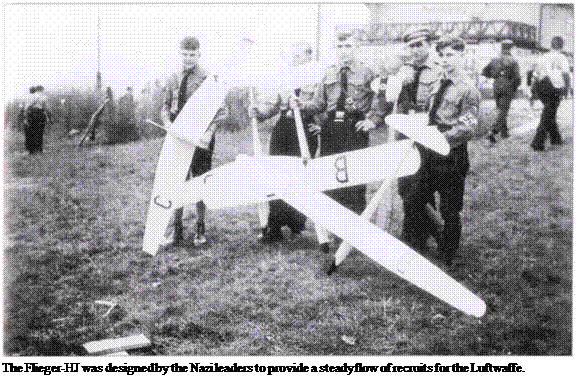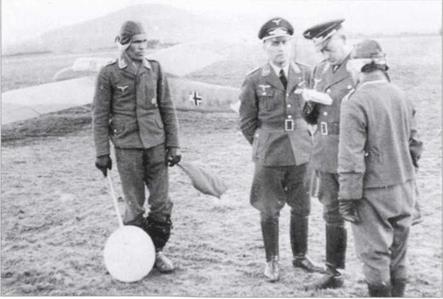Aviator Training for Special Purposes
|
F |
rom 1943 the Luftwaffe found itself in a predicament. The offensives on all fronts had petered out, and the high command had been forced on the back foot for the first time. A number of engineers were given the task at the beginning of 1944 of devising a way to regain air superiority from the Allies. Using every possibility to the full, with the harshest employment of forced labour and concentration camp slaves, it should be possible, so they reasoned, not only to increase armament production to previously unheard-of levels, but also to bring completely new aircraft into mass production very quickly, be it the midget fighter, whose many parts could be made at a number of different manufacturers, or ‘special aircraft’which promised the pilot little chance of survival.
In the closing phase of the war, OKL tried not only inadequately developed designs such as the Volksjager, but also completely new concepts. Having the pilot recumbent, for example, would enable him to perform flight manoeuvres at very high speeds and so win him a tactical advantage over enemy machines. In the steepest turns, they calculated, it should be possible to out-manoeuvre even the most agile Allied fighter aircraft to shoot them down. Other ideas gained ground, particularly ramming. Using the Reichenberg (a manned V-l), a particular target could be destroyed in a ‘total mission, a euphemism for suicide operations. Young pilots, imbued with National Socialist ideology, understood that any means was right and justified for Endsieg (‘final victory’), and this led in 1945 to the adoption of kamikaze tactics. The fact was not openly declared to that section of German youth which, from 1944 onwards, wanted to make its contribution to the victory of the German Reich by volunteering for ‘Aviator Training for Special Purposes’.
Victory Lying Down
Throughout their period in power the Nazi authorities attached great importance to the earliest possible basic training of youth, especially the Hitler Youth, as a source of supply to the Wehrmacht and SS. In May 1944 there were over 210 glider camps in which 10,000 Hitler Youth and a few older NSFK (National Socialist Flying Corps) men served, and were trained to fly various gliders. Not

for want of trying by the training staff it was found impossible to make a pilot of everybody, and the number of young men found suitable for the Luftwaffe successfully completing basic NSFK aviator training was modest. Some 500 of the 10,000 glider-trained Hider Youth were considered for continuation training as operational fighter pilots.
The increasing air raids on targets in the occupied territories and against cities and industrial complexes in the Reich caused ever higher casualties. German losses rose swifdy month by month. Possibly decisive for the further course of the war would be locally based protection of industrial installations, particularly oil refineries. A fast-climbing rocket fighter with relatively limited range would provide them with a minimum of cover. To fly these awkward machines required well-trained pilots. The use of glider pilots after only a short tactical course and training in aerial gunnery was not promising. Hitler Youth applicants for evaluation were required initially to furnish an A, В or C certificate in gliding. From thousands of applicants only a few hundred suitable for further training would be selected and sent on to development centres. Upon successful completion of a selection course, those who had passed were then transferred to Brno for the ‘Fighter Pilot Recruitment Course for Special Purposes’.
|
Towards the end of the war the Luftwaffe was no longer so fussy about personnel. ‘Foreign pilots’of many ethnic backgrounds were being trained from 1944. |
After their arrival at Trebbin, Laucha and other training establishments, the short introductory period was followed by flying training on the Kranich. Nothing was to be known about future operational machines. All young pilots were sworn to secrecy and forbidden to photograph the very unusual glider.
In mid-September 1944 it seemed probable that Erich Bachem’s vertical take-off BP 20 Natter local fighter would be ready for trials by the end of the year. So that the makeshift aircraft might enter service as soon as possible, training was begun in the late summer of 1944. It was agreed between Bachem and the RLM that 50 recumbent seats planned for the earlier version of the Natter would be manufactured and delivered to Grunau for the first Liegekranich gliders. The firm of Schneider would convert the training aircraft on hand accordingly. The contract was awarded on 29 September 1944. Ludwig Hofmann was selected to prepare the training course for future Natter pilots at Trebbin. For this purpose Oberst Gollob permitted him to take part in Me 163 training from the end of September.
Bachem had stipulated in his specification for the Natter that the normally most dangerous flight phase, landing, was not difficult, and consequently future pilots would need only basic flying knowledge, the В-licence being sufficient, covering the ability to fly in three dimensions with special instruction in Natter technique tacked on. A two-seater trainer with the flight characteristics of the Natter would be provided, special emphasis being placed on familiarizing the pilot with the unusual pilot seat. Later the young pilot would be shown the flight characteristics of the machine and how it behaved at high speed. Approaches would follow against moving targets. The approach itself would be a kind of dogleg. Great importance was attached to the final shooting phase, for the limited flight time of the Natter did not provide for a second opportunity.
The training aircraft had room for the pilot to squat. The instrumentation and control unit were identical to the later operational aircraft. The flight instructor would handle take-off and landing in the two-seater. In order to impart flying knowledge earlier it was planned to have a lower wing loading than the operational version. A powerful winch was provided for take-off. Touchdown speed was 80 km/hr (50 mph). The pilot would round off the session by firing a Schmeisser at a mock-up of a bomber. It was thought that this would arouse his sporting instincts and enable him to acquit himself swifdy in this area of the training programme.
After completing the shooting and basic flight requirements, the pilot would then fly a training machine with greater wing loading. The winch would be replaced by an aircraft tug to reach greater altitudes for further exercises in shooting and closing in on enemy bombers. Next would come flights in a training Natter with pulse jet astern. Rocket-assisted starts and approaches towards moving targets now came to the fore. Whether a flight in a series-produced Natter was to have followed is not known: it is suspected that upon passing out of training, the young pilots were to have been made operational immediately and thrown in at the deep end. Since the Natter never did become operational, what happened in effect was that the successful candidates were merely told that they would pilot some kind of flying machine from the recumbent position. The courses were broken off earlier than planned, however, and the Hitler Youth candidates were packed off to perform their compulsory six-month RAD (Reich Labour Service) obligation.
Work on the Natter was not completed to plan and operations were never contemplated. Continuation training, at least of pilots intended for the Natter, scarcely emerged from the theoretical stage. Since using very young pilots to fly the Me 163 was doubtful since there was no fuel, and series production of the Но IX was a long way off, all efforts were in vain, while the development and building of the Me 163 В was suspended on 5 January 1945 on the orders of the armaments controllers and the Chief-TLR.
As the Red Army headed for Berlin, its advance forced a halt to training at Brno on 19 March 1945, and its transfer to the Reich Glider School at Trebbin. Initial flight training was diverted to Laucha, but never got under way. So that students would pass smoothly to a rocket fighter, part of the training during the second phase was with the Stummelhabicht. After completing glider training it was intended that applicants selected for the Me 163, Natter or similar aircraft should undergo a short course of flight training in a motorised aircraft (Bii 181) at Leipzig, but this idea was abandoned, mainly for shortage of fuel.
When shown a training film on the Me 163, the young pilots swifdy expressed doubts as to whether they could handle it, and the same occurred at courses where pilots would fly their machines in the recumbent position. Even instructors had problems flying the converted gliders of the Habicht and Kranich types while recumbent, because they were difficult to control generally.











